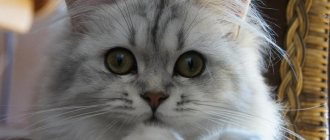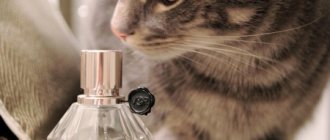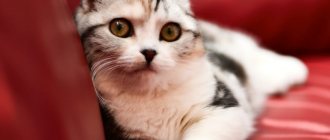Home » Useful Information
“Mom, let’s buy a kitten!” — it is with this phrase that many families begin their acquaintance with furry purrs. However, not all parents think it’s a good idea to have a cat for their child. But are mustachioed and striped animals as dangerous for children as they are imagined to be?
- 2 How to properly raise a cat and a child
2.1 How to choose a cat for a child2.1.1 The best and worst cat breeds for children
- 2.1.2 Photo gallery: cat breeds for children
The best breeds for children
It is advisable that parents do not give their child a long-awaited pet, but choose it together.
Important! There are a number of breeds that breeders have been working on for a long time, selecting and purposefully developing qualities that are important for life in a family, in an apartment - a guarantee that the character of a cat is easy to predict, it quickly adapts to the home and over the years becomes an excellent companion for a child.
What qualities are valued in an animal destined to become a friend and grow up with a baby?
| Patience | Children can accidentally hurt the cat. Many cat breeds take this calmly, realizing that a human cub is not an aggressive enemy. |
| Low level of territoriality | At the genetic level, cats strive to protect their territory, but a cat in the house must understand that people, even small ones, are above it in the hierarchy. |
| Activity level | Of course, playful breeds are suitable for children and are fun to play with. A passive animal that sleeps most of the time will not suit children. The cat should enjoy interacting with humans. |
| Lack of defensive-aggressive reaction | When frightened, a cat may scratch or bite. This is a normal reaction. But animals that specifically lie in wait for a person and attack from around the corner are not suitable for children. Vicious and aggressive cat breeds are very rare, but it is still worth excluding them from the list. |
| Stress resistance | Yes, children are noisy, so the animal must have a high level of stress tolerance. A timid or nervous pet will not get along in a family with children. |
It is worth considering in detail those breeds on which breeders have worked well.
Which cat is best for a child?
Each cat breed has its own characteristics, which it is better to know about in advance, and its own character. If there is a child in the family, it is of course better to choose a cat among non-aggressive, friendly, playful breeds. Before purchasing, familiarize yourself with the characteristics of the breed and prepare for possible difficulties.
If you have decided on a breed, pay close attention to the breeders . Unfortunately, there are now more and more people who are trying to make money from breeding without caring about the health of the animals. A low cost may indicate that the animal was raised in poor conditions and fed cheap food, without veterinary control, or the kittens were the result of inbreeding. Such cats can have a number of serious defects and diseases.
It is important for parents to remember: no matter what animal they get, they must carefully monitor the health of their pet. Firstly, we are responsible for those we have tamed, and secondly, our smaller brothers themselves can become carriers of some diseases dangerous to humans if basic prevention rules are not followed.
Be sure to visit a veterinarian for a preventive examination and vaccination at least 1-2 times a year. At least 2 times a year, you should drive away worms with special means: even if the cat sits in the apartment forever, you yourself can bring helminth eggs or dangerous viruses from the street on your shoes. When going outdoors, don’t forget to treat your fur against fleas and ticks.
It is also better to immediately discuss with your doctor the method and timing of sterilization of the animal : this will protect the cat from a number of diseases and improve its disposition. Teach your child to always maintain hygiene and wash their hands after contact with an animal. A healthy cat can become a true friend to you and your children and a full member of the family for many years.
Persian cat is a family favorite
The cat is one of the oldest and most popular breeds. Its name suggests that it comes from the Persian region, which corresponds to today's Iran. Males weigh up to 7 kg, females 3-4 kg. The breed standard calls for a stocky body with short legs. The head is round with a short flat nose. This head shape reflects the "child schema". Animals that fit this pattern, that is, with large eyes and a round head, are perceived by humans as especially “cute.”
The Persian cat has current “fashionable colors” or pattern options. The lower half of the fur is silvery white, towards the top of the tip the fur is pigmented in color. There are smoky versions of all coat colors.
The breed is peaceful and calm. Animals are usually afraid of strangers. Persian cats have a strong desire for freedom - they are ideal as house cats. They are not lazy.
Their long fur with a thick undercoat makes the Persian cat one of the most high-maintenance cat breeds. It should be brushed daily to remove dead fur and prevent tangling. Skin inflammation and fungal infections can quickly develop under matted areas of fur. In addition, preventing the formation of hairballs in the digestive tract of a Persian cat is very important. Therefore, she is very demanding in care.
British Shorthair
When thinking about what breed a cat should be - a friend and playmate for children, many felinologists (cat specialists) give a clear answer: British.
This breed includes long-haired and short-haired animals, but a pet with a plush coat and short hair is more suitable for children. According to legend, the famous Cheshire Cat was a British Shorthair.
Britons are companion cats. Play? Yes. Sleeping in an embrace with the owner? Yes too. This breed is not phlegmatic, but has a balanced, calm temperament. It is very difficult to anger a Briton; aggression is not characteristic of him.
The advantage of this breed is self-sufficiency. Animals are not annoying and do not require constant attention. They have excellent intelligence, and over the years they develop their own opinions on various matters.
This is an ideal option for keeping in an apartment: the British are clean, and for maintenance it is enough to comb their fur coat once a week.
Such cats have good health and strong immunity.
Another plus is that the British live for 15-20 years.
Be sure to involve your child in the choice, do not give a personal gift - a pet
Also pay attention to the character, temperament of your baby, whether he has diseases (for example, an allergy to wool), the size of the apartment, income (some breeds of cats require certain and obligatory expenses). All worries will still fall on you, think about it - do you need this? Or is it easier to refuse your child? If your answer to the first question is yes, then move on to our rating of kitten breeds for your children!
The oldest cat breed in the world, the Persian is a loyal, gentle, non-obsessive, and affectionate pet with a balanced character, who loves to sit in arms and cuddle. The owners note a certain patronizing and condescending attitude on the part of the pet. Not suitable for noisy hours, for children and adults with allergies; they constantly need to take care of the coat, comb out tangles, while at the same time receiving a portion of communication.
Scottish Shorthair
Thanks to a gene mutation, humanity received a new breed that quickly gained popularity, and for many people the question of which cat is best to get for a child has only one answer.
Scottish Folds are real cuties with an excellent character, ideally adapted to the modern person.
Kittens are playful and tame from birth. Children love that Scots are easy to train and you can play ball with them and watch TV. They know how to stand on their hind legs - this is a normal manifestation of interest on their part. Tired of children's noise, the cat simply hides - aggression is not typical for her.
Very socialized animals, they have a calm character, do not require constant attention, and respect the human right to solitude.
It is believed that the Scots choose their owner, and simply love the rest of the family members.
It is convenient to keep such a cat in an apartment: it does not make loud sounds, is very clean, quickly understands the rules of behavior and follows them. Care is simple: just brush the animal regularly, wash the eyes and clean the ears.
Due to a gene mutation, cats do not have very strong joints, and owners need to remember this.
Neva Masquerade cat
The origin of the breed has not yet been precisely established. The cats are said to have been seen near the Neva River in Russia decades ago. It owes its melodic name to its face mask. Thus, as a relatively young breed, it is a true lover of nature and is still less known in our regions.
In appearance, they resemble a mixture of the Sacred Burma and the Siberian forest cat. Their shiny, belted fur comes in many shades of color and patterns that only fully develop in the first few weeks of life. Her moderately large body is supported by strong legs and large round paws, and her beautiful face is adorned with bright blue eyes and a wide bridge of the nose. Their thin but dense fur is longer and more luxuriant in winter than in summer, because in the cold season they have a thick undercoat. Regular cleaning is required weekly.
Since the Nevsky Masquerade has an affectionate and cheerful nature, it is perfect for keeping at home. She also enjoys having fun with her owners and is especially fond of children. She is a sociable and patient cat who follows family members wherever they go.
Tips for choosing
If you want to have a cat in your apartment, then you need to think about the most suitable breed, especially if there is a child in the house. Among the most favorable exotic cats recommended for a home where children live are:
In order to choose a good cat that will be friends and play with the child, will not offend him in any way, and will get along with the rest of the household, you need to take a responsible approach to the selection of the breed and the upbringing of the kitten. When purchasing a small furry friend, it is best to take with you an experienced veterinarian or cat specialist who will immediately identify congenital abnormalities or abnormal behavior of the animal. If this is not possible, then after purchasing it is worth taking the kitten to the veterinary clinic and having a full examination done in order to safely allow the pet to see the child.
For a successful purchase, you need to have clear ideas about the breed you are interested in, its external characteristics and character traits, so as not to become a victim of a deceiver who sells an incomprehensible cross between cats for a lot of money. Both children and adults should choose a pet.
If you are going to get a cat at home, you need to purchase all the necessary equipment - a tray, a container for food and drink, a place to rest, a scratching post. And most importantly, read the literature on raising cats and teach the basics to your child. Only in this case will the purchase of a cat be successful and the whole family will have a mischievous friend.
To find out which cat breed is best for a child, see below.
What selection criteria should you focus on?
The choice of sex of a four-legged pet is influenced by many factors. One of the most important criteria is the type of home in which the owner lives. We must not forget about those who live next to him. The presence of small children and other pets must be taken into account. An important factor will be how the new pet tolerates loneliness and long separation from a loved one.
In an apartment or private house
When thinking about whether it is better to have a cat in an apartment or a country house, you can read forums or chat with experienced owners. Most often, in a city apartment it is recommended to have cats. Females are cleaner than males, do not leave odorous marks, and do not scatter litter. In addition, keeping a girl in a confined space will not result in an unplanned pregnancy, because the owner can control her social circle.
Cats love to spend time on the couch and on a person's lap. They don't need the open spaces of the street to feel happy. But the female, unlike the males, is much more effective in ridding the country house of annoying rodents. Cats quickly lose interest in monotonous hunting and find other activities - mainly guarding the territory and clashes with neighboring cats.
Boys prefer the opportunity to go outside the home. They want to run, jump, climb trees. Males need to feel like masters, so they mark their territory. Finding such marks in an apartment is not very pleasant. A private house will be the optimal habitat for boys.
Affectionateness
The furry pet is very sensitive to the attitude of family members. If someone doesn’t like him or offends him, the two-legged animal avoids him.
Girls are more prone to reciprocal affection and tenderness from the owner. Kitties become more attached to a person and better adapt to his character. Cats are more independent in this regard. They are more interested in climbing a tree or curtain than purring in the arms of their owner.
Intelligence and ease of education
The behavior of mustaches directly depends on their upbringing
It is important to instill in children the norms of behavior in the family from early childhood. Representatives of any gender and breed respond well to the persistent demands of the owner
However, females are more flexible in this regard. They will fulfill a person’s demands, so as not to offend him, to please him.
Males, on the contrary, will prefer to run away, hide, rather than obey. It is more difficult to train them to use the cat litter box and not to throw litter around. After a walk outside, males will immediately jump onto the sofa, and the girl will patiently allow her to wipe her paws.
Independent representatives of the cat family that do not like to obey humans and are difficult to train include the British, Russian Blue, and Scottish Fold breeds. But sphinxes, bobtails, and orientals are ready to do anything for the sake of their owner, so they can be trained without any problems - regardless of their gender.
Are there small children in the family?
Females are much more obedient and affectionate than males. They are less likely to scratch and bite
In a family with a small child, this is very important. The male is accustomed to dominating and defending his position no matter what, so he is capable of harming the baby
You must understand that no animal likes to have its tail pulled, constantly pressed and squeezed. It is necessary to explain to the child that this is not a toy, but a living creature with its own character. Sooner or later, both girls and boys can react equally aggressively to persistent caresses and disrespectful attitudes.
Are there other animals in the family?
Because of their inherent mentality, girls share their territory with other pets much more easily. And the tendency to dominate, characteristic of boys, forces them to show their superiority over the rest of the inhabitants. It is especially difficult for two cats to get along in one place. They constantly fight for leadership, arrange showdowns, and mark their territory.
Even castrated males are unlikely to make friends - most likely, their conflicts will subside, but a strong friendship will not work out. If there is an adult cat in the house, it is not advisable to take a second adult male - it is better to take a female or a very small kitten.
Cats get along with other animals depending on their character, and gender does not have that much influence on this. Even a brutal cat can become an affectionate nanny for a horde of puppies, ferrets and even chicks - if his disposition is completely peaceful.
Outbred
It is unknown what character traits a cat adopted from the street or from a shelter has. She may turn out to be a playful fidget, a calm aristocrat, or a feisty one.
However, most often, street kittens quickly become attached to a person and accept the rules of behavior in the apartment.
Such cats are not very sociable - this is fixed at the genetic level. But the former homeless animal is self-sufficient, not annoying and unobtrusive. At the same time, an even, warm relationship is built with children, but the kitten is unlikely to allow itself to be commanded.
After adopting an animal from the street, owners need to do a full veterinary examination.
Canadian Sphynx
Canadians are just one of the breeds of so-called hairless cats. There are also Don Sphynxes and Peterbalds.
The statement that sphinxes cannot be a source of allergies is incorrect, because... The allergic reaction is caused by saliva, not fur.
The appearance of sphinxes is peculiar, and many people do not like it, therefore, when deciding what breed of cat to get, you need to be sure that the child will not be scared and will like the “bald” one. One of the features of the Sphinx is its hot, silky skin, very pleasant to the touch.
Sphinxes have high intelligence, but a lot depends on proper upbringing. You can’t shout or scold a cat, just explain to it - the sphinx quickly learns the rules of behavior in the apartment. These animals are not vindictive, patient and usually choose one owner, perceiving other people as friends.
Sphynx cats do not tolerate loneliness well: they like to sit on your hands or knees, but do not impose their company, they are not averse to playing and jumping - a height of more than a meter is not the limit for them.
Caring for a cat without hair is simple: you need to regularly wipe it and wipe its eyes.
A distinctive feature of sphinxes is increased heat transfer, which is why the animals get very cold and require special clothing.
Hypoallergenic cat breeds
Canadian Sphynx
- child friendly
- smart
- hypoallergenic
- not picky eaters
- special skin care
- prone to colds
Recommend: Hypoallergenic cats: 9 breeds
Russian blue
- excellent to train
- get along with other animals
- unforgiving
- timidity
- can't stand noise
Cornish Rex
- cheerful disposition
- easy care
- don't shed
- can't stand loneliness
- hyperactivity
Ragdoll
Ragdoll is a blue-eyed miracle.
This breed was registered in the 1960s. Breeders claim that this is one of the cutest and most gentle cats. They follow their owner like dogs. And they are not irritated even by the pestering of small children - they never use claws or teeth in games. However, when getting a ragdoll, you need to be prepared for the fact that their luxurious coat will require regular care.
Abyssinian
It is believed that this is what the cats of the ancient Egyptians looked like, images of which are found in the tombs of the pharaohs. The breed appeared in Europe in the 19th century.
These are intelligent and active animals. They cannot stand boredom and always find something to do, being present wherever something is happening. If the owner communicates little with the animal and does not play, the Abyssinian begins to play pranks.
They love to communicate with children, treating them condescendingly, but it is important for children to understand: the Abyssinian, unlike other cats, can and wants to determine the rules of the game himself. It is better not to allow children under 3-4 years of age to approach these cats.
The apartment is a bit cramped for cats; they need a spacious play area to play.
Of course, as a long-bred breed, Abyssinian cats quickly understand what a person requires of them, but the traits of independence in them are still strong.
Cats of this breed quickly contract a fatal disease - leukemia, but the animal can be protected by a simple vaccination. The oral cavity requires attention. Once every 2 weeks you need to wipe your ears.
American Curl
The main difference between the Curl and other representatives of the cat world are the ears that are turned outward. They are the ones who give the pets a joyful, but slightly wary appearance. The coat is soft and silky with minimal undercoat. It can be either short or long. Adult pets are of average size, weighing from 3 to 5 kg.
Newborn kittens are born with straight ears; only by 4 months are they fully formed. Various colors (bicolor, solid).
This is a curious, loyal, eccentric, loving friend. They adore children and are very attached to the breeder. They get along well with other animals.
With folded ears I like I don't like
Siamese
Siamese are called dogs in cats' skin. This breed has an interesting feature - its voice: Siamese are able to change the pitch and tone of sound due to the structure of the vocal cords. They need physical contact, so they are sociable and playful.
This is a good friend for children, because the Siamese cat can be trained, it loves active movements and bustle. If a Siamese takes a child under his wing, he will protect and love him until the end of his days.
The Siamese have no equal in their ability to achieve their goals, even the most mischievous ones. They love to jump and move around on top, so a play area with high platforms should be made for them in the apartment.
It is believed that Siamese cats are vindictive and take revenge for insults, but this is a myth, because excellent long-term memory is characteristic of all cats: they are able to remember throughout their lives what impressed them.
A short-haired Siamese only needs to be brushed occasionally; it can be taught to swim from childhood - these cats love to swim in warm water.
Long-haired varieties of Siamese are the Balinese and Burmese cats.
Which breeds are better not to choose?
If a pet is needed in the house as a playmate for a child, special attention should be paid to the interaction of the animal with people.
What breed of cats are not chosen for children:
- Ragdoll. Genetically fixed incredibly calm temperament. It is very difficult to make such a cat play and run. She is not aggressive, but overly melancholy.
- Persian. These cats are irritable and dislike noise and children's activity. If you force your dog to play, he may bite.
- American Curl. Friendly and playful, but this breed is not suitable for children - Curls do not like cuddles and children's hugs.
- Himalayan. Not suitable due to its long, beautiful coat, which requires considerable effort to tidy up.
- Turkish Angora. Prefers the company of adults, communicating with them through sounds.
All long-haired breeds for children are not an ideal option, because during play the hair will be in the child’s mouth, and the injured animal will begin to show aggression.
Important! Children do not need representatives of recently bred breeds with loose character traits.
Kind and friendly breeds
Siberian
pros
- do not require special care
- smart
- not picky eaters
- friendly
Minuses
- special hair care
- aggression towards pets
Siberian cats are very affectionate and intelligent. They love playing together with kids, showing great activity and independence. Adults must explain to younger family members that the Siberian cat is not a plush toy. If she gets hurt, she will put out her claws. Pets are very attached to their little owners - they constantly follow them and even sleep next to them.
Abyssinian
pros
- devotees
- graceful
- non-aggressive
- affectionate
Minuses
- hyperactive
- they meow loudly at night
Abyssinians are known for their attitude towards children - they are affectionate, peaceful, and devoted. The breed is more suitable for children over 10 years old who love active games in which the pets take an active part. They happily climb high cabinets, slides, etc. They are not very interested in being with kids - representatives of the breed do not like to sit still for a long time. Smart and easy to train.
Siamese
pros
- attachment to a person
- mind
- easy to train
Minuses
- vindictive
- jealous
They are considered one of the kindest among other cat breeds for children. Siamese fiddle with them for a long time, even sleep in cribs. It is important that the cat feels that she has not been forgotten with the arrival of a new family member. It is necessary to regularly stroke, scratch, and talk to her. Then she will be affectionate and gentle. Older children need to be explained that Siamese are vindictive - if the animal is hurt, sooner or later it will take revenge on the offender.
The calmest and kindest cats
Many people prefer to have purebred cats. Among the huge variety of breeds, how can you choose the one that is best suited for living in the same apartment with your child?
There is a rating of representatives of the cat family, as if specially created for families with children. It includes Ragdoll, Devon Rex, Munchkin, Oriental, Scottish Fold, Siberian, Russian Blue, Burmese and hairless cats.
Ragdoll - a “rag doll” for a baby
This is the undisputed leader in the list of the best cats for children. The Ragdoll takes an honorable third place among the largest domestic representatives of this family. Only the Savannah and the Maine Coon are larger. Due to their low muscle tone, these cats have the unique ability to literally go limp in a hug. It is thanks to this feature that they got their name - from English it translates as “rag doll”.
The most affectionate cat breeds
The kindest and most gentle pets are those that completely trust people and never show aggression. Affectionate cats treat all members of the owner’s family equally well and sincerely suffer from lack of attention.
Devon Rex
This affectionate and conflict-free cat is famous not only for its unusual appearance, but also for its infinitely loyal disposition. He tries to accompany the owner everywhere, and this good fellow reminds of his presence with a quiet purr.
The Devon Rex loves to spend time in its owner's arms and does not tolerate prolonged absence of communication with people.
Sphinx
Due to the lack of fur, this tame cat needs warmth. She does not tolerate loneliness well and is loyal to strangers. Despite her stern appearance, the Sphinx has a friendly and gentle character.
He needs constant contact with people and enjoys spending time on his master's lap.
Burma
Active, curious and kind cats can listen to their owner for hours. Quiet, unobtrusive Burmese never show aggression and do not meow without good reason. These affectionate cats love to sleep in their master's bed and are easily accustomed to walks.
Friendly and patient, Burmese treat children well and do an excellent job as a nanny.
Siamese
Intelligent, curious and rather kind cats choose one owner for themselves, but treat all family members with respect. Despite their affectionate nature, they do not tolerate rough treatment and can extend their claws in defense.
Active and intelligent Siamese easily remember different commands, but do not tolerate coercion and achieve what they want with the help of loud meowing.
American Curl
These beautiful cats with ears turned outward have an angelic character. Gentle American Curls are completely devoid of arrogance and desire for independence.
Kind and loyal pets have a strong emotional attachment to their owners and do not tolerate separation well.
Tonkinese cat
Egyptian Mau
These cheerful and active cats have an energetic temperament and affectionate disposition. They quickly bond with people and are one of the most loyal breeds. Although Egyptian Mau tend to choose a single owner, they treat all family members with trepidation.
Kind and affectionate cats willingly accept attention, but do not have the habit of imposing themselves.
Cornish Rex
Funny and active cats remain active until old age and love playing with children.
Himalayan
This is one of the kindest cat breeds with an understanding and friendly disposition. Intelligent and affectionate, Himalayans love attention and willingly accept their owner's care.
They easily get along with people of different ages and are suitable for families with children.
Selkirk Rex
This active and playful cat with a good-natured and affectionate disposition is devoted to one owner, but treats all family members well. The Selkirk Rex loves to be petted and enthusiastically participates in children's activities.
Ragamuffin
This is one of the friendliest cat breeds with an affectionate and easy-going disposition. Calm and patient, Ragamuffins quickly get used to their owners and are good with children. They allow babies to carry them in their arms and stoically endure any children's pranks.
Recommend: Should you get a second cat?
Kind and affectionate cats try to be closer to their owners and never show aggression.
Balinese (Balinese)
Javanese cat
These affectionate and tame animals are highly human-oriented. They try to accompany their owner everywhere and be closer to him. Kind and sociable Javanese do everything to get the next portion of attention, and are very bored when alone.
Snow-shoe
Havana brown
These friendly and affectionate cats have a sociable and loving disposition. They treat their owners with great tenderness and value comfort very much. The non-aggressive and friendly nature of the Havana Brown cat quickly turns it into the favorite of all family members.
Laperm
This soft, loving and kind cat has a strong attachment to people and does not tolerate indifference. Often he chooses one owner.
The affectionate and friendly laperm is lenient towards children's pranks and almost never lets out its claws.
Oriental
Neva Masquerade
This curious, active and cheerful cat is suitable for families with children. She feels the same affection for all members of the household and is never intrusive. The kind and affectionate Neva Masquerade cat loves to “talk” and knows how to console a sad owner.
Siberian
This highly intelligent and devoted cat has a sensitive, balanced disposition. Behind the external calm of the Siberian lies incredible power and self-esteem. The affectionate and playful cat is a good hunter, so it is ideal for those who live in a private home.
Singaporean (Singapura)
Russian blue
Somali (Somali)
Manx (Manx)
Scottish lop-eared
These are the most suitable cats for children. They have a beautiful appearance, a soft plush coat and an easygoing disposition. Kind and affectionate cats are endowed with high intelligence and are easy to train. They adore their owners, but do not like loud, harsh sounds or rough handling.
Shorthair exotic
This is one of the calmest cat breeds. Beautiful, kind and affectionate exotics will not refuse to take a nap next to their beloved owners. They get along well with children and get along well with other pets.
General tips and tricks
Having decided which cat is best to get for a child, you need to carefully consider the issue of choosing a specific kitten.
How to choose:
- Age. If it is difficult to determine the age of a street kitten, then you need to buy an animal from a nursery that is 8-14 weeks old. At this age, the kitten begins to be accustomed to adult food, it is sufficiently socialized, it is easy to accustom it to the toilet and the rules in the apartment.
- Health. You need to look under the tail: the anus should be dry and clean. Health criteria: eyes and ears without discharge, clean shiny fur, belly is round, but not tight or sunken.
- Behavior. A healthy kitten should be playful, curious, and active. A cat that is too cocky or too quiet means problems with upbringing in the future.
You need to pick up the kitten you like and look at its reaction. Lack of aggression, calmness and a share of healthy curiosity is right.
If the kitten is interested in its future owners, it is possible that it was for them that it was born.
Precautionary measures
Important! If there are doubts about the health of the kitten, then it is better to refuse to buy such an animal.
It is worth carefully monitoring your cat’s behavior on the street so that it does not have contact with yard cats. If they are not looked after, they become a breeding ground for bacteria and helminths, which can easily be transmitted to a healthy pet through contact.
The veterinarian also makes a significant contribution to preventing the child from becoming infected. It is necessary to undergo all mandatory examinations and give the cat vaccinations, which are recommended by the doctor. Then both the cat and all family members will be healthy.
Hygiene rules help protect your child from infections
Useful properties of cats
A furry pet is not only a responsibility and a chore, as future owners think, but also a huge benefit for the child. There are a huge number of beneficial factors from cats, these include:
- A four-legged pet can teach a child responsibility not only for himself, but also for people close to him;
- Babies who grow up next to cats rarely get sick, and, as a rule, are less prone to allergic reactions;
- At a certain age, a child simply needs a four-legged friend, because furry pets are natural antidepressants;
- Pets that are with the baby not only during the day, but also at night, can have a positive effect on the psycho-emotional state during sleep.











